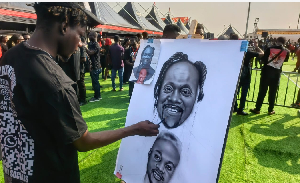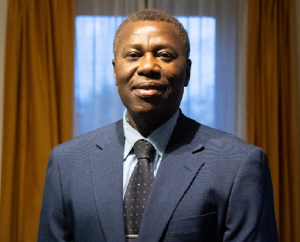By Cynthia Ama Mills
JUASO, THE capital of the Asante Akim South district is one town in the Ashanti regionwhich is bedeviled with a protracted chieftaincy dispute which has persistedfor close to 20 years. Juaso is reported to have two chiefs or better still twopeople are claming to be the chief of the town.
On November 21, 2005, I had the opportunity to ask thequestion: Who is Chief of Juaso? in a wrte-up in the Kumasi Mail
Barely fouryears on the National House of Chiefs has not provided any meaningfulintervention in the impasse neither has the National Security Council, workingthrough the REGSEC and District Security Committee over two regimes been able to provide the dreadedanswer to this simple question.
In the face ofthe apathy of those entrusted to ensure peace, law and order, I am tempted tofurther ask if there is a chief at Juaso at all. Of course, there is achief. And so who is this chief?
In trying tohazard an answer let us find out who a chief is. A chief by definition is“someone who has duly been nominatedand installed on the Black stool inaccordance with custom and tradition to protect properties and interests of the people”. In short, a chief is the leader of a tribe orpeople.
The situation atJuaso currently is a case of two claimants: the case of Nana Owusu AchawPrempeh II against that of Barima Safrotwie Sarpong II.
In 1994, NanaOwusu Achaw Prempeh was allegedly destooled. He is contesting the purporteddestoolment charge in court. The kingmakers of Juaso say they have notdestooled their chief to warrant the enstoolment of a new chief.
Four years laterBarima Safrotwie Sarpong II was said to have been enstooled as the Juasohene onSeptember 10, 1998. While at these, the National House of Chiefs deleted NanaOwusu Achaw’s name in May 2004.
It took theNational House of Chiefs seven years to enter Nana Sarpong's name in theNational register of chiefs on March 15, 2005. The Juaben Traditional Councilwhose kingmakers enstooled Nana Sarpong as chief of Juaso, has since accordedNana Sarpong recognition. Kingmakers of Juaben installing chief of Juaso?
Could these bethe bases of the Juaso chieftaincy dispute? Why does Nana Sarpong not want tobe chief of Juaben (Second Juabenhene?) where kingmakers installed him chiefbut want to be the chief of Juaso which already has a chief?
Nana Owusu AchawPrempeh claims he is the chief of Juaso and rightly so. Why not? Even after hispurported destoolment in 1994 theNational House of Chief which claims the man is destooled continues to addressNana Owusu Achaw as Juasohene in their correspondence of February 2005.
Nana Owusu AchawPrempeh has given good reasons for his claim while questioning the claim ofNana Sarpong.
Nana Owusu Achawhas referred to Section 48 (i) ofthe Chieftaincy Act 370 of 1971 which states that “ a person registered as a chief cannot statutorily perform the functions of a chief until he has been gazetted in the Local Governmentbulletin by the Minister of Local Government. I think Nana Prempeh isright to see himself as the “gazetted”chief while looking at Nana Sarpong as a “registered”chief.
Mrs. JusticeGeorgina Wood, now Chief Justice, on October 25, 2006 ruled while presiding at the Supreme Court that “ it is settled law that entries made in ordeleted from the national Register of Chiefs do not constitute adjudication ordetermination as to who is a chief or not, but rather a purely administrative act.”
Going by thedefinition of a chief, it presupposesthat any one who has not been installed on the Black stool and has not sworn the oath of allegiance to the stool elders is not and cannot be a chief.
In the contextof the above, I am tempted to ask if Nana Sarpong has been installed on a BlackStool. Where and by whom? The only group of performs on record to haveinstalled Nana Sarpong as chief is kingmakers of Juaben (See DailyGraphic of Monday September, 2005 which stated that “Nana Sarpong wascustomarily installed Juasohene by kingmakers of Juaben” at a time the Juabenhen, Nana Otuo Siriboe II, who signed the esntoolment form inaccordance with section 51 (1) of theChieftaincy Act, 371 (Act 370) was informed that the so-called Juasohene was not in possession of the Blackstool and other stool property.
The Black Stoolis being kept at the palace which is occupied by Nana Owusu Achaw Prempeh. Soonce again, who is the chief of Juaso? Why is the national House of Chiefs notasserting itself on the matter?
The RegionalSecurity Councils of past governments have exhibited their biases by takingsides. Their role seems to be fanning the dispute rather than settling it. Iwould not be surprised if the new regional Minister as the head of the REGSEC supports Barima Sarpong’s claim and give him the recognition to the extent of extending all courtesies and privileges ofa chief while he is not as explained above.
I could careless about the two chiefs of Juaso but for the fact that this dispute is nowaffecting school children in the area.
Year in year outschool since 2006 children at Juaso are deprived of the experience of theIndependence Day anniversary. The town folk are subjected to police/militarybrutalities in one way or the other. You, dear reader, can just imagine thetrauma children go through fleeing from gunshots of the security men includingprivate ones.On August 14, 2006 residents of Juaso weres scared by the presence of 170 armed police personnel drawn from Kumasi, konongo and Agogo. (See page 7 of Bono& OseikromObserver of August 30, 2006).
Last year,parents had to rush to protect their children at the Independence Day parade.
This year, therewere reports of gun shots. Soldiers actually fired gunshots at the parade todisperse irate youth who decided to cheer the school children in their marchpast. The police broke umbrella of chiefs and brutalized some of the youth.Four people got injured during a scuffle between the youth and securitypersonnel.
Now, in spite ofhard evidence of brutalities, the Denkyeminasohene of Juaso, Nana Osei Boansi Kuffuor II speaking for andon behalf of Juaso Divisional Council(?)
says media reportswere calculated “to discredit the good and professional work done and exhibited by the Juaso Police Command which had been reinforced by police and army detachment from the Ashanti Regional Command for the occasion. The reinforcement had been necessitated because of the unnecessary andunruly behaviour of the supporters of the ex-chief of Juaso, Nana Owusu AkyawPrempeh,” the Denkyeminasohene said defending that there were no gun shots at theparade at all. That is well taken. He also claims that only one person by name;Kwabena Atuahene got injured while the police were able to arrest only threepersons who were the ringleaders who wanted to disorganize the Independencecelebration.
He alsodescribed the youth as supporters of the ex-chief. Why was there a scuffle andwho is the ex-chief?
According tohim, Nana Owusu Akyaw Prempeh had been informed by the Police command in Ashanti not toattend the Independence Parade either personally as a chief or to be representedas a chief by any of his followers,because he is not the chief of the town. Who is?
The purportedrestriction of Nana Prempeh is explained by the Denkyeminasohene that the recognized chief of the town, Barima Safrotwie Sarpong, had been invited by the Ashanti Regional Co-ordinating Council headed by Mr. Kofi Poku Manu to attend the Independence parade and that if he (Nana Prempeh) wished toattend the parade, he could go there as an ordinary person and not as a chief , to witness the function.
Why did NanaSarpong also not attend if he is the recognized chief by the RCC? Whoeverdeployed these security men to Juaso must be preparing to answer the charge ofwillfully causing financial loss to the state. Their presence at Juaso was notnecessary because there was no war there. The RCC, which should by now knowthat two persons cannot captain one ship, caused unnecessary tension. In fact,Juaso is not a battle field and a training grounds for the security agents.The resdidents are not pigs either to be experimented on with deadly weapons.
What is thegovernment’s position on recognition of chiefs? Should the one be merelyregistered or gazetted? I think I read something like “Government recognizes only gazetted chiefs” in the Daily Graphic of March 30, 2001 and hope the RCC would also read this.
Justice, theysay is truth in action. Can somebody say who, in truth, the chief of Juaso is?People of Juaso, who is your chief?
Opinions of Friday, 10 April 2009
Columnist: Mills, Cynthia Ama














